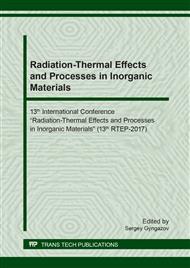p.3
p.8
p.14
p.20
p.25
p.30
p.36
p.41
Radiation Defects in HCC Materials at Atomic Spatial Level
Abstract:
Diagnostics of the irradiated structure was carried out using the field ion microscopy technique. Modes of radiation exposure for development of amorphized states in subsurface regions of platinum are determined. It is shown that radiation exposure of pure metals with an energy of E = 30 keV under variation of the fluence of the charged argon ion beams by two orders of magnitude (1016 to 1018 ions/cm2) produces a significant effect on the kinetics of defect formation in the subsurface regions of irradiated materials. As a result of irradiation up to a higher fluence (F = 1017 ions/cm2), the effect of formation of the block nanocrystalline structure (at the block size of 1–5 nm) is observed in subsurface regions at a depth of at least 20 nm from the irradiated surface. It is found that the phenomenon of metal amorphization in the subsurface regions occurs up to a sample depth of 12 nm under an increase in the fluence to 1018 ions/cm2 and the above irradiation energies. Experimental results on atomic–spatial investigation of radiative defect formation in surface layers of materials, initiated by ion implantation (in Cu3Au: E = 40 keV, F = 1020 ion/m2, j = 10–3 A/cm2), are considered. The experimentally established average size of a radiation cluster (disordered zone) in the alloy after ion bombardment is 4 × 4 × 1.5 nm.
Info:
Periodical:
Pages:
14-19
Citation:
Online since:
September 2018
Authors:
Price:
Сopyright:
© 2018 Trans Tech Publications Ltd. All Rights Reserved
Share:
Citation:


